APS Spotlight
APS Teaching Fund Showcase: Psychological Detective Activity Boxes
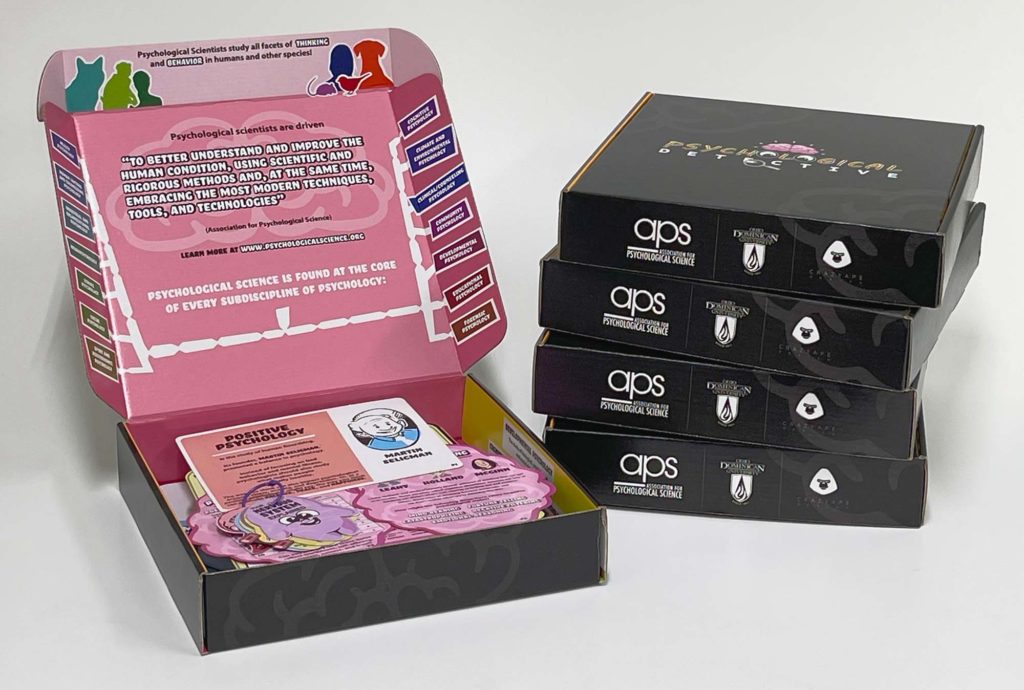
Image above: The 2023 Psychological Detective Activity Box.
Providing young learners with hands-on psychological science resources can give them the exposure they need for their own personal development, while also fostering the future of a behavioral health workforce, according to John Marazita, a psychology professor at Ohio Dominican University.
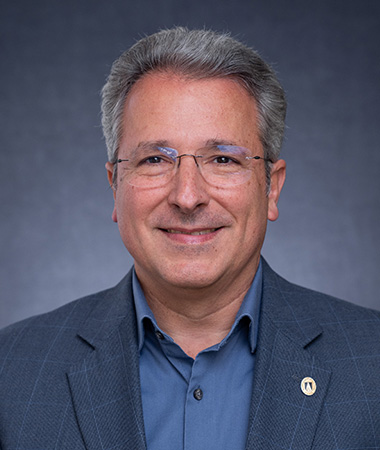
With the help of a $5,000 grant from the APS Fund for Teaching and Public Understanding of Psychological Science, Marazita and Maryam Elmajadoubi, an undergraduate honors student, worked with Crazy Ape Design (www.crazyapedesign.com) to create Psychological Detective Activity Boxes as an innovative way to provide young students in central Ohio with these resources and promote a new generation of psychological scientists.
The APS Fund for Teaching and Public Understanding of Psychological Science was established through a $1 million endowment from the David & Carol Myers Foundation. For more information on the fund, visit psychologicalscience.org/smallgrants.
Tell us about the Psychological Detective Activity Box.
The idea behind this project comes from observations and experiences I have had over the past several years. The timeline below summarizes the development.
1. In 1998, I developed a summer enrichment experience for middle school students through the Higher Education Council of Columbus (Ohio) titled “The Psychological Detectives.” The students and I explored a variety of topics related to sensation, perception, memory, and problem solving.
Grant Information
- Awarded: June 2022
- Amount: $5,000
2. In 2010, I wrote a proposal to teach the course through the Chautauqua Institution’s Special Studies Program (Chautauqua, New York), and I have had the pleasure of teaching several versions of it since then. Through my work at the Institution, I continued to refine the activities, and, in 2016, I developed a kit to support our work. This kit included materials to demonstrate and conduct mini experiments exploring visual illusions, stereoscopic vision, face perception, and memory. This became the prototype for my APS proposal.
3. In 2016, I began volunteering as a judge for the local school district’s science fair. I was struck by the small number of behavioral science projects relative to other STEM disciplines. Moreover, support for behavioral science research among elementary, middle, and high school students appears to lag behind support for other STEM disciplines.
4. Several years ago, I saw an advertisement for KiwiCo’s subscription boxes (see www.kiwico.com), which led to a search of subscription boxes. I discovered many for the “sciences” but none for psychology. In the APS grant proposal, I reported that of the 19 “best” subscription boxes for children (Peterson, 2022), the single largest category focused on STEM, but none addressed psychological science (arts and crafts was another popular category).
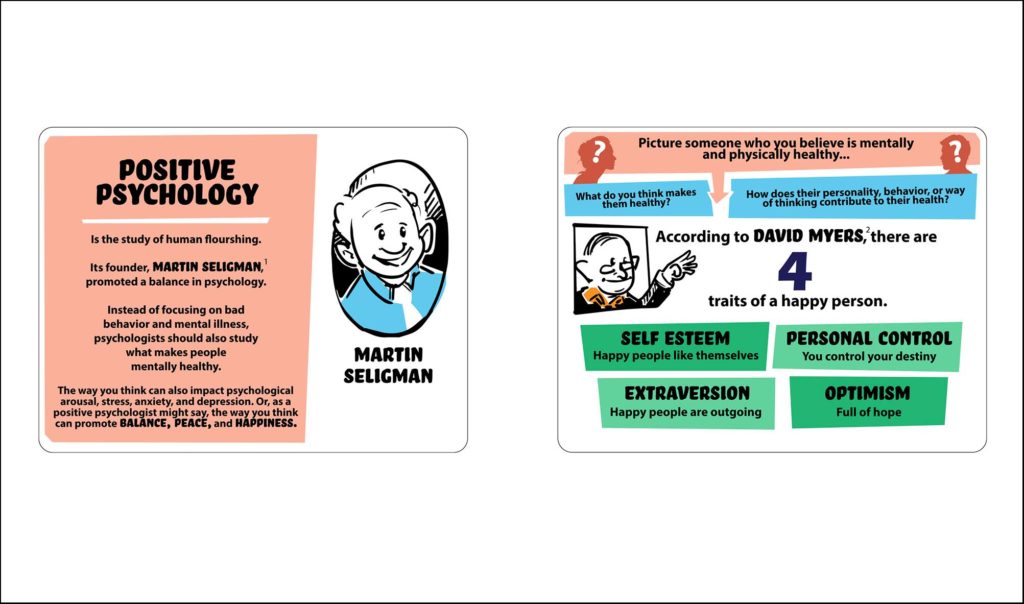
Psychology is missing out. This is especially concerning given the mental health crisis reported across the country. If we are to grow the next generation of psychological scientists and clinicians, we need to give children early exposure to the field. I fear that without a stronger presence of psychological science, students’ understanding will likely be rife with misconceptions, and many will not consider psychology to be a viable career path. Indeed, much has been written about teaching introductory psychology courses by addressing the many misconceptions and myths students bring to the classroom: But why wait until college? APS has been working to fill this gap, and the Teaching Fund has supported several projects designed to reach high school, middle school, and younger students. I read descriptions of this work over the years, and then it clicked—why not formally develop the activity box in APS’s tradition of making psychological science accessible to all?
Learn more about the APS Fund for Teaching and Public Understanding of Psychological Science.
The need for such opportunities is greater than ever. In his 2022 State of the State Address, our (Ohio) governor expressed concern about suicide, record levels of accidental drug overdose deaths, worsened rates of depression, anxiety, addiction, and post-traumatic stress disorder, the high rate of children experiencing one or more adverse childhood experiences, and poor access to care. Governor DeWine called for significant investment in growing our behavioral health workforce, increasing research and innovation, and building community capacity for care. While I suspect the governor has more immediate initiatives in mind, we also must play the long game. Children’s exposure to psychological science is a critical step for their personal development and for growing a behavioral health workforce by attracting future generations to the field.
Read all of the articles from the September/October Observer.
In addition to providing psychology-related experiences to younger students, the project also included the opportunity for undergraduate students to play a role in determining the topics and activities to include in the box.
What role did the Teaching Fund grant play in developing this project?
With APS’s support, we developed and piloted the first-ever Psychological Detective Activity Box. The first “official” box, which we started distributing in March 2023, raises awareness about the field and includes activities and mini experiments to explore positive psychology, stress, and well-being. The Teaching Fund grant provided me with the resources (and motivational boost!) to make this happen. Whereas the box I created in 2016 for the Chautauqua Institution was a plain white cardboard box with homemade materials, the 2023 APS box is professionally developed and produced—a collaboration that included me, undergraduates, and an experienced toy designer.
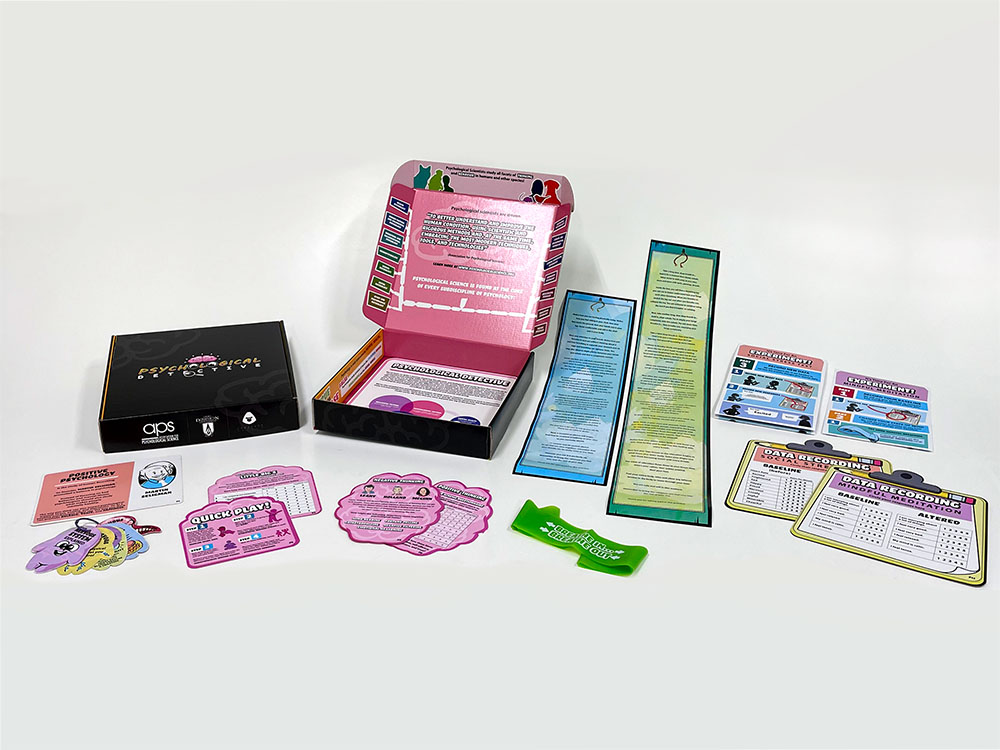
The grant allowed us to distribute the box free of charge to classes of middle school students, who provided data for us to evaluate their learning and experience. We distributed additional copies to other teachers and school psychologists. We also plan to use the box in upcoming programming. We are very grateful to APS and especially the David & Carol Myers Foundation for making the grant possible. As of the publication of this article, we have distributed 90 Psychological Detective Activity Boxes.
What was the application process like?
In a word, the process was efficient. I found all sections of the application to be relevant, and the questions were meaningful and helped me think through every aspect of the project. APS offers two deadlines, which is also very helpful. The review was timely and APS staff have been very supportive and responsive.
The APS Teaching Fund provides small grants for projects that promote the teaching and learning of psychological science. Application deadlines are March 1 and October 1. View the application instructions.
Tell us about the development process.
Summer 2022
The period immediately following news of acceptance involved further conceptual development. For example, colleagues in the field of education provided feedback on the activity box’s potential for intergenerational experiences (e.g., applicability to children and adults, including older adults). I explored this in my summer 2022 Psychological Detectives course at the Chautauqua Institution. Rather than opening the course to children only, we welcomed all age groups. In the end, 10 students enrolled ranging in age from about 12 to 81, including a mother and her son. I also piloted activities that might lend themselves to future activity-box topics.
Fall 2022
I offered a research seminar to four undergraduate students, one of whom (Maryam Elmajadoubi) took a lead role developing the first APS Psychological Detective Activity Box. In addition to reading about the science of learning, we also read articles related to proposed box topics (e.g., mindful breathing in children, positive and negative schemas in child well-being, social stress). Maryam took the lead and helped to guide us toward meaningful activities that are developmentally appropriate. Over the course of the semester, we designed the box itself (the physical container) to provide a general background about psychological science, and we sketched out the specific contents. We presented our ideas to the toy designer (Crazy Ape Design, www.crazyapedesign.com), who developed physical contents for our consideration. By the end of the term, we had created the following activities for children:
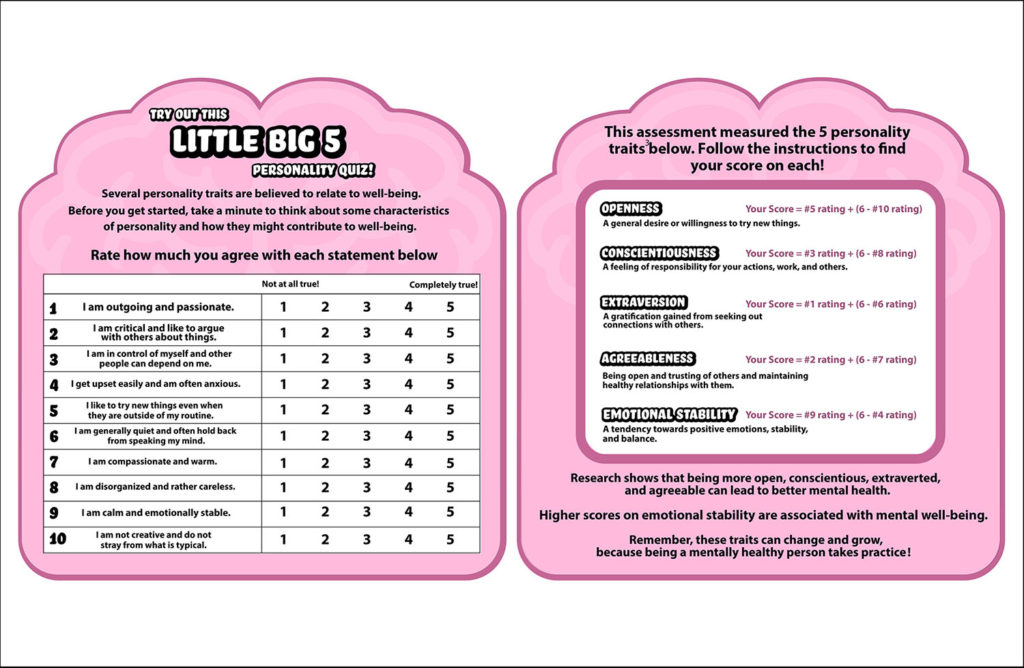
- An illustrated card presenting background on Positive Psychology to serve as the context for the box.
- A “quick play” activity to demonstrate how physical activity impacts the nervous system, and a manipulative to illustrate branches of the nervous system and their function.
- A “Little Big 5 Personality Quiz” to encourage students to think about how personality traits (e.g., introversion, extraversion) relate to responses within the autonomic nervous system.
- An activity to teach them about negative thinking (citing research by Leahy et al., 2011) and positive thinking (citing research by Keyfitz et al., 2013). Physical activity and personality impact stress responses, but so does one’s pattern of thinking. We included a portion of Keyfitz et al.’s Positive Schema Questionnaire for children to complete (with permission from the publisher).
- An activity on the impact of social stress that invites students to play the roles of experimenter and participant in an adaptation of the sing-a-song stress test between pre and post assessments of well-being. The activity also teaches them about informed consent.
- Another mini experiment to assess whether mindful meditation and progressive muscle relaxation affect well-being. The above activities lead up to the question of whether we can impact stress responses. The box included a “stretchy band” to help students visualize and time their breathing, and instructions for mindful breathing and progressive relaxation were printed on scrolls. Visually appealing data-recording cards were included for students to record their pre and post well-being scores for comparison.
- A final informational card ties activities together by illustrating the biopsychosocial model.
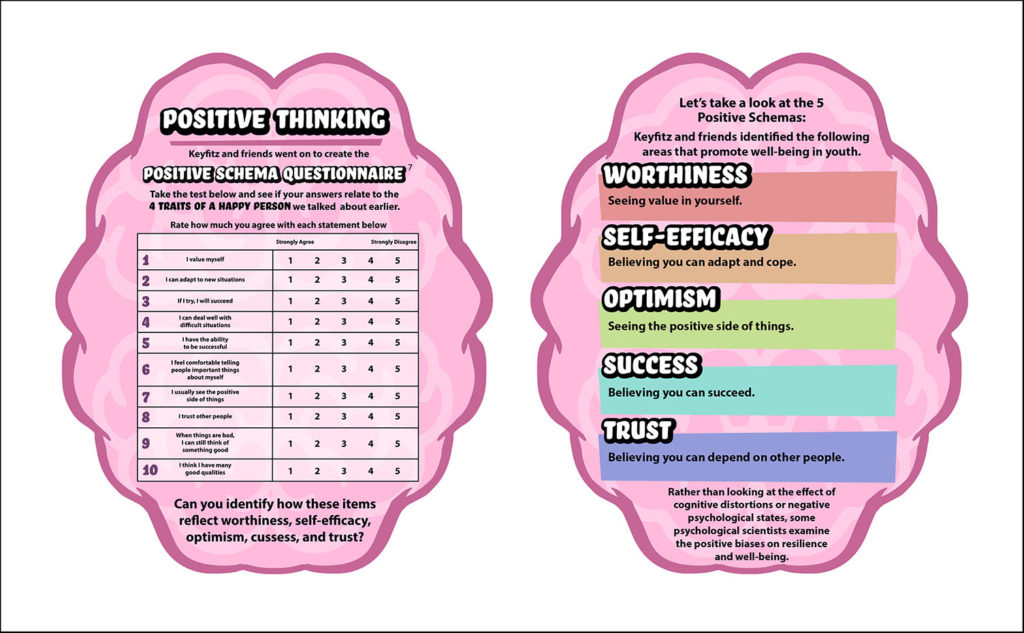
Spring 2023
We continued to refine and edit the activities through several meetings with Crazy Ape Design. Once the boxes and materials were produced, we distributed them to middle school students for use in the classroom. With their parents’ permission, students recorded their data from the activities on a Microsoft Form, which was returned to us after identifying information had been removed. The undergraduate student in charge of the project conducted analyses and reported the findings as part of her capstone thesis project.
How have students reacted to using the activity box?
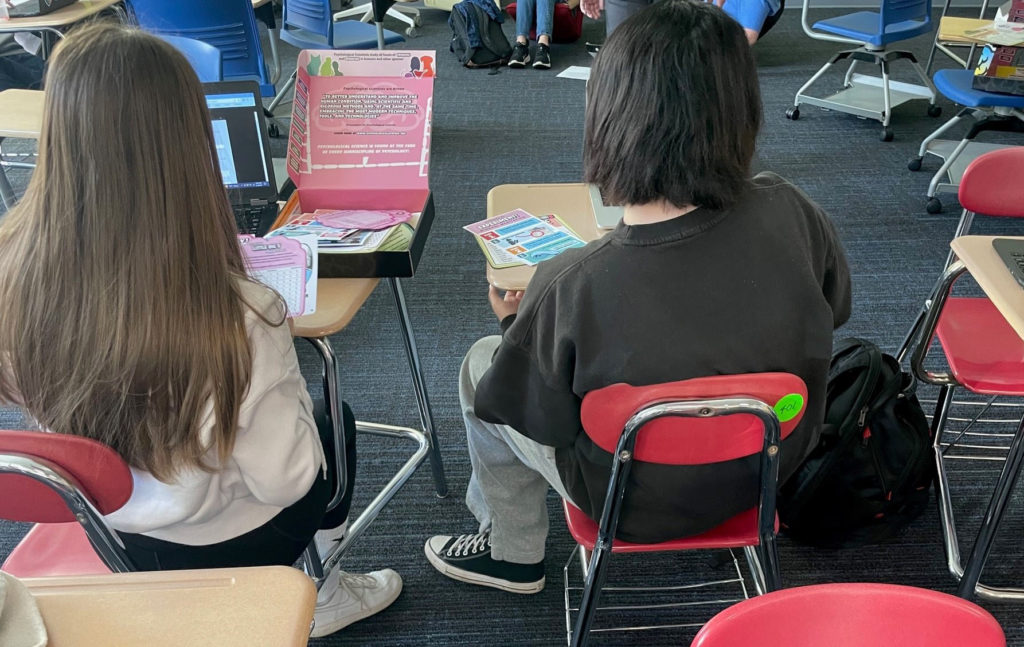
Students seem to have taken the activities seriously. We conducted reliability analyses of the various measures we used (one taken from past research and others developed by us) and found our findings to be consistent with past research and within range to conclude that the measures were reliable. While obviously uncontrolled, we found that positive affect was increased after the breathing activities and negative affect was decreased. There was no difference between progressive muscle relaxation and mindful breathing in this regard. We reported these findings to the teacher but unfortunately were not able to engage the students in conversation about it.
Middle school students are very honest. While many reported enjoying their interaction with the box, many provided constructive feedback that we are using to improve it. For example, as you may have concluded when reading the description of the box’s contents, there was a lot there! Too much. The flow of activities and development of concepts from one to the next could be improved. We are working on developing a clear user guide and a reduced set of activities for the next edition.
Advice for Researchers Applying for APS Teaching Fund Grants
Apply! As psychological scientists, we have a responsibility to communicate our findings to others, including those outside of the scientific community. I would point out that the APS Teaching Fund is not just about what we do in the classroom with undergraduate and graduate students. The full name of the fund is the APS Fund for Teaching and Public Understanding of Psychological Science, and I believe we have a lot of work to do in this area. APS has been a leader in promoting the teaching and public understanding of psychology not only through the activities this grant has sponsored but also through the accessible podcasts and videos it offers.
How has your grant from the APS Teaching Fund supported your work?
I am in the process of shifting my scholarly agenda, in part because of the COVID-19 pandemic. Over the past 30+ years, I have enjoyed conducting research on preschoolers’ metacognitive development and its relation to language acquisition. I was in the middle of a project when the pandemic shut us down and we were no longer able to visit preschools for data collection. My progress even before the pandemic was slow because of my teaching and administrative responsibilities. I decided that it was time to move in a different direction. I am now focusing on how I can direct my interest in children’s cognitive development toward developing opportunities for them to explore psychology. In my basic-level research, I always enjoyed developing protocols to collect reliable and valid data. I have created toys, illustrations, storyboards, and games, and the activity-box project allows me to continue this part of the work, although for the purpose of education rather than basic-level research. The APS Teaching Fund allowed me to move meaningfully in this direction. Moreover, this activity also supports my work with undergraduates as they play a key role in this project.
What are your future plans for the Activity Box?
A grant to support the future development of the project is under review by a local foundation. Our future plans include the following:
- Revising the first edition to improve its focus and organization, including a user guide to support the use of the box outside of the classroom.
- In the tradition of Darwin and da Vinci, adding a research journal to the box to encourage students to record data, their own observations, and responses to prompts in the user guide.
- Developing extension activities to help students expand box activities into more-involved science fair projects.
- Expanding box topics. New boxes will focus on a variety of topics related to thinking, perception, memory, problem solving, etc. Regardless of topic, each box will emphasize the common thread of psychological science.
- Partnering with several organizations to get the boxes in the hands of more children from a greater diversity of backgrounds. We plan to connect with after-school, summer, and other enrichment programs.
- Developing a summer program for middle and early–high school students using the boxes and led by undergraduate students.
Anything else you wish to add?
I have nothing to add except my thanks for the opportunity to have this work described in the Observer, and of course to APS for the grant. In case you cannot tell from my responses, I am very excited by the path I am on, and the grant was instrumental in allowing me to take my work to the next level!
Feedback on this article? Email apsobserver@psychologicalscience.org or login to comment. Interested in writing for us? Read our contributor guidelines.
References
Keyfitz, L., Lumley, M. N., Hennig, K. H., & Dozois, D. J. A. (2013). The role of positive schemas in child psychopathology and resilience. Cognitive Therapy and Research, 37(1), 97–108. https://doi.org/10.1007/s10608-012-9455-6
Leahy, R. L., Holland, S. F. J., & McGinn, L. K. (2011). Treatment plans and interventions for depression and anxiety disorders. Guildford Press.
Peterson, B. (2022, February). The 19 best subscription boxes for kids – 2022 Readers’ Choice Awards. My Subscription Addiction. Downloaded from https://www.mysubscriptionaddiction.com/best-subscription-boxes/best-boxes-for-kids





APS regularly opens certain online articles for discussion on our website. Effective February 2021, you must be a logged-in APS member to post comments. By posting a comment, you agree to our Community Guidelines and the display of your profile information, including your name and affiliation. Any opinions, findings, conclusions, or recommendations present in article comments are those of the writers and do not necessarily reflect the views of APS or the article’s author. For more information, please see our Community Guidelines.
Please login with your APS account to comment.